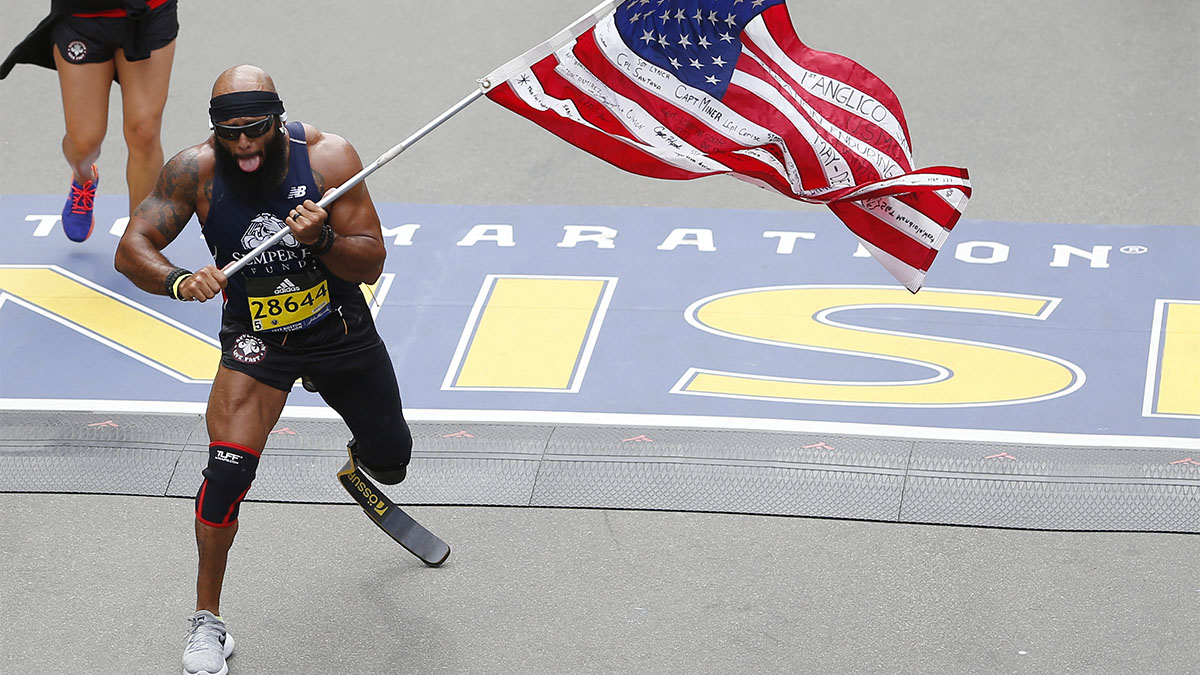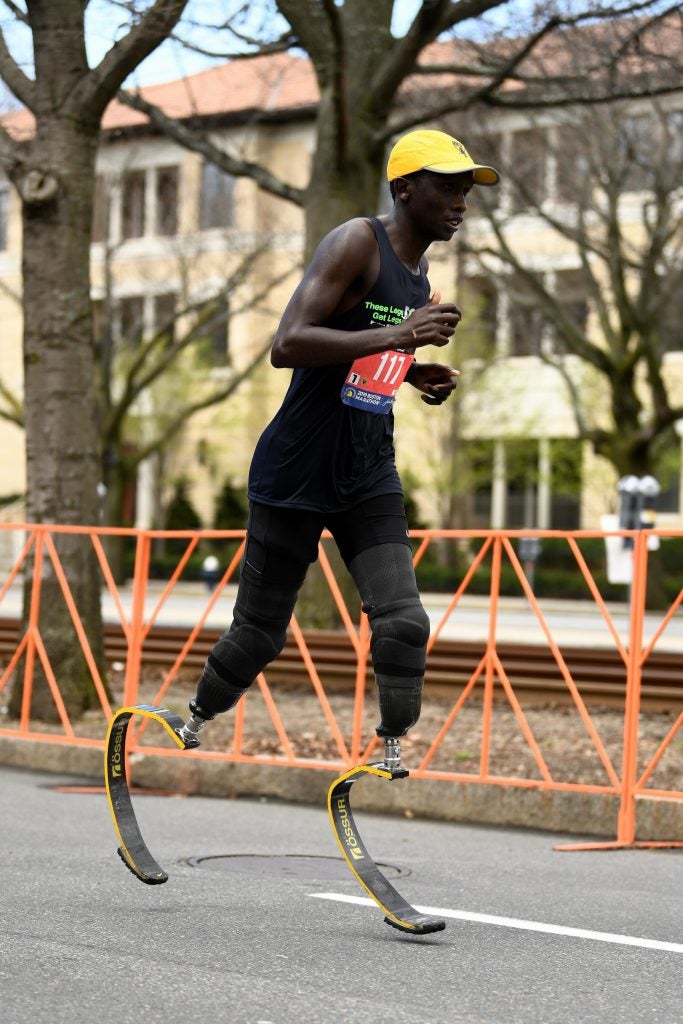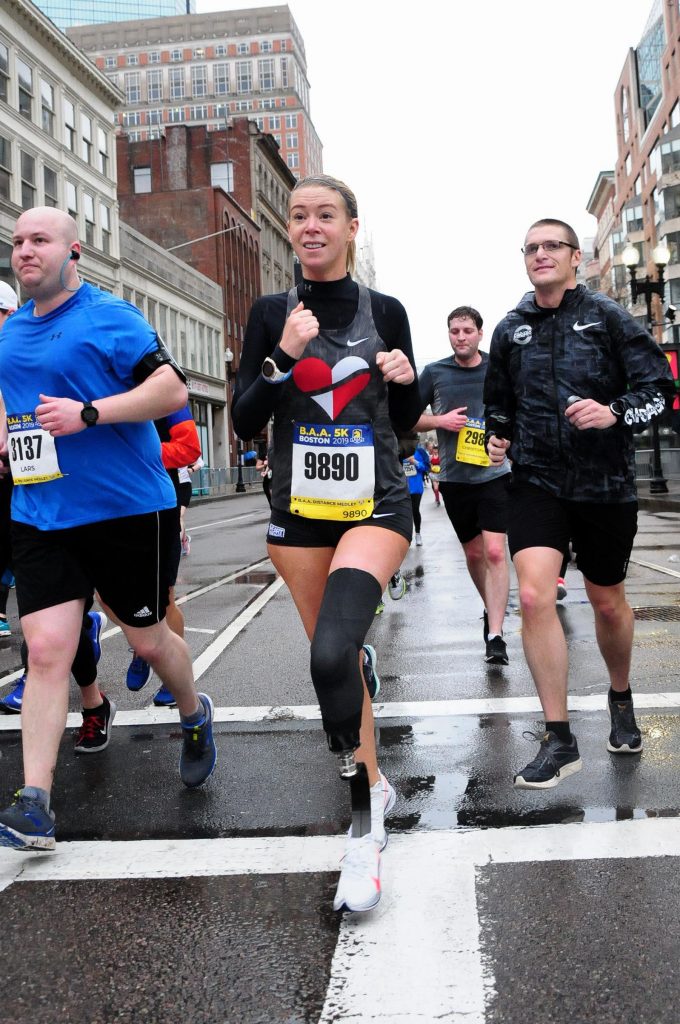Recognizing competition, Boston adds para athletics divisions

In 1975, the Boston Marathon was the first of the six Abbott World Marathon Majors to add a wheelchair division.

In 2020, Boston will be the first to include a competitive para athletics division for ambulatory para athletes.
Athletes in wheelchairs have had a designated division that recognizes their highest achievements with awards and prizes, but other para athletes have not. The Paralympic Games do not include a marathon for athletes who run with protheses.
The number of ambulatory athletes with physical challenges who compete in the Boston Marathon has grown steadily, said Marla Runyan, the para athlete manager with the Boston Athletic Association (BAA). Years ago, about a dozen athletes with limited or low vision ran Boston; now that number is well into the 50s, she said.
Even some of the most groundbreaking performances can go unnoticed without a division to recognize them.
“I have observed Paralympians coming to race in Boston and in other major marathons, and no one knows they’re there,” Runyan said.
In the 2019 Boston Marathon in April, Marko Cheseto finished in 2 hours, 42 minutes, 24 seconds, breaking the world record for runners with double lower limb prostheses. He was the first mobility-impaired runner to cross the line. “I ran the fastest time in the world. Yes, there is recognition that I ran it, but there are no prizes for winning it,” he said.

Athletes like him who devote themselves to training so they can achieve great things should have the opportunity to compete for prize money just like other athletes, he said.
The athletes who run Boston have “tremendous athletic accolades behind them in terms of their performances, whether on the track in the Paralympic Games, or the World Cup, or the Commonwealth Games, and yet, we’re not recognizing them,” Runyan said. So she set out to create a framework that would.
The new classification categories the Boston Marathon recognizes include vision, upper limb and lower limb impairments, following the International Paralympic Committee (IPC) Classification Code. To compete, athletes must meet qualifying standards for their age, gender and class. Awards and prize money will be given to the top three male and female finishers in each category. The aim is to establish a level playing field for competitive athletes with various disabilities. Other major marathons are likely to follow suit, Runyan added.
This framework mirrors what’s already in place for other athletes, Runyan pointed out.
“You have an elite field; you have an emerging elite field; you have athletes aspiring to run their personal best, and you have charity runners running for a cause — you have the full range of folks racing with different motivations and different athletic abilities, and that same continuum exists among the para athlete community.”
Runyan has a unique perspective on competing. In 2000, she became the first legally blind track and field athlete to compete for the U.S. Olympic Team, and she is the only visually impaired U.S. athlete who has competed in both the Olympics and Paralympic Games. She recalled wanting “to be seen and recognized as an athlete, first and foremost, and not as a person with a disability who participates in sport.”
It’s difficult to be seen as an athlete first “when you have a disability, because that’s what the media gravitates toward,” Runyan said. “And that’s what I hope we can start to change — we can start to tell stories of athletes first and foremost, and have that be the new story.”
Beyond Boston: “What it has the potential to do is create a greater visibility, so that our younger generation who is sitting there watching TV says, ‘Oh my gosh, there’s an amputee who just ran a 2:42 marathon. Maybe that can be me someday,’” Runyan said. “You have people you can identify with in the event, and I think we all look for that.”
Adrianne Haslet agreed. She had her left leg amputated after being injured in the 2013 Boston Marathon bombings, and she has since run Boston on a prosthetic leg.
“I get letters and messages daily from amputees and from parents of new amputees — or a child that is about to become an amputee due to health issues — and they’ll say, ‘They’re looking at you and seeing that you’ve run,’ ” she explained.
Haslet was a competitive ballroom dancer before the bombing. Then, when she became a runner, “I saw the elites crossing the tape in marathons, 5Ks, and 10Ks, and thought to myself, ‘How awesome will it be when I am fast enough to do that?’” she recalled. “Then I looked and thought — wait, there is not a division for para athletes, for amputees.” So she made it her mission to push for one, and she approached the BAA.
“We should be included because we are athletes, and we are wanting to compete,” Haslet said. “To not even be included is demeaning, and I’m so grateful that the BAA has seen that and seen the opportunity and what it can do.”
Separate divisions are important for the same reason separate men’s and women’s divisions are important, Haslet explained.
“If someone said, ‘Well, why couldn’t the women just compete with the men?’ We aren’t going to put up with that. We want our own division. It shouldn’t be any different for an amputee runner.”
And the Boston Marathon’s announcement is already inspiring kids, Haslet said.
“That night when the announcement came, I got videos of parents telling their children — you know those videos of parents telling their kids they’re going to Disneyland? — I got videos of them saying that they could train for the Boston marathon and win it.”
The opportunities for ambulatory para athletes to race marathons competitively are limited, Cheseto pointed out. In the Paralympics, “for my class, T-62, there is no marathon category. So this is a huge opportunity to get that para section in the Boston Marathon,” he said. Cheseto ran cross-country and track at the University of Alaska at Anchorage, and he lost both legs below the knee to frostbite.
“I want to show people that, regardless of our physical challenges, we as human beings have that resilience, and we are able to perform at our highest levels, regardless of our disabilities, given that opportunity,” Cheseto said.
Many people have talent but lack a platform to prove that they can perform at a high level, he added.
The para divisions mark the BAA’s transition from “Athletes with Disabilities” to “Para Athletic Divisions” and “Adaptive Programs.” Runyan explained. “We wanted to come out from the label of disability — we wanted to update our language and terminology to align with the Paralympic movement and emphasize athletic ability.”

Haslet also advocates focusing on ability, not disability.
“I want to show others who are doubting themselves in their lives — that are in my same position — that what they can do far outweighs what they cannot do,” she said.
“When Shalane Flanagan or Molly Huddle or Eliud Kipchoge runs the streets, we aren’t thinking about what they can’t do. We’re thinking about what they can do.”
And it’s not just about the Boston Marathon, Haslet said. “It’s about competing. It’s about belonging.”
Runyan added that the public is used to seeing stories of participatory para athletes, which is a good thing.
“But we’re missing out if we’re not also hearing and seeing athletes with very high goals and expectations athletically, who are setting world-best times and have goals of racing in the Paralympic games,” she said. “This framework evolved as an opportunity to recognize and elevate these athletes and their athletic achievement, first and foremost, while still maintaining our adaptive program, which provides opportunities for more recreational athletes.”
There’s room for improvement in educating people about high-achieving para athletes, especially in the U.S., Runyan said.
“Paralympians in the U.K. are household names. In the U.S., no one even knows,” she said. “And that’s unfortunate because there’s so many great athletes that we’re missing out on an opportunity to recognize. So my hope is that this is going to be a part of that change and part of that movement.”
Cheseto said he hopes that this “will also open other avenues, not only in marathons, but also road races like 10Ks and 5Ks, to get more para sections for these athletes to be able to compete at these different events.”
Haslet has become an advocate for amputee rights.
“When I became an amputee, I had no idea there were other amputee athletes out there,” Haslet recalled. “Of course there were, but I had no idea. The more people see para athletes, when they see someone running next to them in a race, or someone standing next to them in the grocery store line, I think they’re more accepting of what they can do instead of what they can’t do.”
Changes elsewhere in sports might also be helping to redefine who qualifies as a serious athlete. Shaquem Griffin was drafted into the NFL. He had his left hand amputated when he was 4 after being born with amniotic band syndrome. Runner Justin Gallegos signed a contract with Nike, and he is the first athlete with cerebral palsy to do so.
“Griffin, being in the NFL, has clearly proven we are not defined by our disabilities — but overcoming what people think of us,” Haslet said. “It’s not even being defined by what we can do, because we could do it the whole time. It’s just being accepted by the masses.”
Both Haslet and Cheseto are looking forward to racing in Boston’s new para divisions in 2020.
Cheseto said he hopes the new divisions offer “encouragement to all these other people with physical challenges out there — just letting them know that, regardless of their situation, whether we are recognized or whether there is a platform for competition on all these events, the thing is: If we get out there and show the world that we can also perform, somebody’s going to make a change somewhere,” he said. “It’s our hard work and performing at a higher level that would trigger somebody to make that policy change.”
Beyond actually running, Haslet said, “I’m eager to hear how commentators will talk about it — eager for it to be a learning opportunity for the people listening and watching,” to learn the verbiage about the different classifications, as well as the para athletes’ athleticism and training.
For her part, Haslet said, “I want to see what happens if I take this training to the highest level I can and toe that line in Hopkinton. I want to see what I can do.”
Allison Torres Burtka is a freelance writer and editor based in metro Detroit. You can read more of her work here.
Editor’s note: For the coming 2019-2020 academic year, the Global Sport Institute’s research theme will be “Sport and the body.” The Institute will conduct and fund research and host events that will explore a myriad of topics related to the body.
Related Articles
'Forrest Stump's' 1,500 miles a small step to advocate for better athletic prothesis access
Adaptive sport improves quality of life for those with disabilities
Podcast: Traumatic brain injury beginning of Jack Rutter 2.0
Alabama's Stran-Hardin Arena brings adaptive sport vision to life
After a shooting left him paralyzed, DeQuel Robinson finding new life in wheelchair basketball
Video: Love of sport, helping others brought Rola Allahaweh back from near death
U.S. veteran Steve Kirk uses breath-triggered gun at Wheelchair Games

